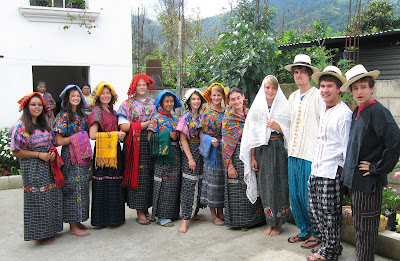

Hey Everyone
Today we sadly had our last spanish lessons. so we all said our last good byes to our teachers. After that we headed off to San Antonio Agua Caliente. There we had a cross cultural experience with a Mayan family. We had lunch with them, a wedding style feast and got to try our hand at tortilla's making. After lunch, Ellen and Joel had a pretty exciting experience, they got married mayan style, we all got to dress up in traditional mayan out fits and experianced the wedding of joel and ellen. we got taught a dance and learned about all the component of what the women would wear in the wedding ceremony. At this place we were also able to see parrots and a lemur. We also got to eat a ton of chocolate covered fruit which was delicious! It was a lot of fun to create realtionships with this close family.
We are going out for a traditional Guatemalan meal now,
Caleb
Today we sadly had our last spanish lessons. so we all said our last good byes to our teachers. After that we headed off to San Antonio Agua Caliente. There we had a cross cultural experience with a Mayan family. We had lunch with them, a wedding style feast and got to try our hand at tortilla's making. After lunch, Ellen and Joel had a pretty exciting experience, they got married mayan style, we all got to dress up in traditional mayan out fits and experianced the wedding of joel and ellen. we got taught a dance and learned about all the component of what the women would wear in the wedding ceremony. At this place we were also able to see parrots and a lemur. We also got to eat a ton of chocolate covered fruit which was delicious! It was a lot of fun to create realtionships with this close family.
We are going out for a traditional Guatemalan meal now,
Caleb

